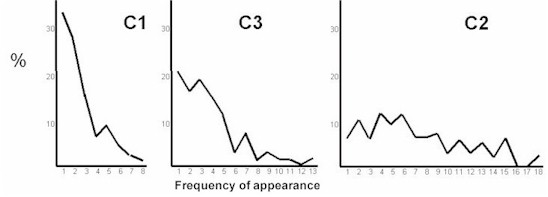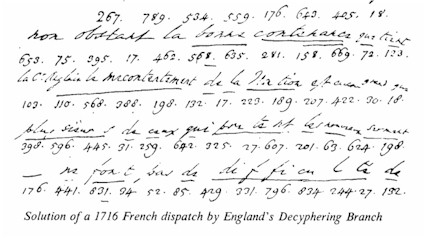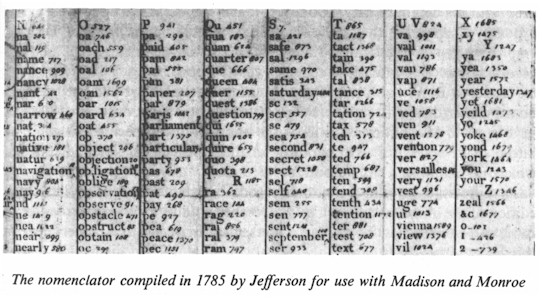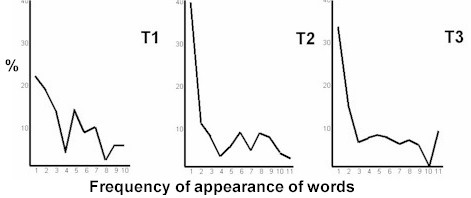|
October 28, 2002
Last update: February 28, 2003
This page was written for those who
know the story of the Beale Ciphers. If you are not familiar with this
fascinating 175-year old tale of buried treasure, the following websites will
bring you up to speed: familiar with this
fascinating 175-year old tale of buried treasure, the following websites will
bring you up to speed:
http://unmuseum.org/beal.htm
http://www.albany.net/~cybernet/beale.htm
There are many other sites and bulletin boards on this
subject.
The book references below are from David
Kahn's "The Codebreakers - The Story of Secret
Writing".
Cipher # 1 (C1) is the unsolved cipher left
by Thomas Jefferson Beale which supposedly describes the location of the
treasure.
Cipher # 2 (C2) is the cipher which Ward
claims to have solved. It describes the contents of the buried treasure,
estimated to be worth over $30 million today.
Cipher # 3 (C3) is also unsolved and
supposedly lists the names of the rightful owners of the
treasure.
These ciphers are in the form of 1 to
4-digit numbers delimited by dots or commas. For example, the beginning of C1 is
: 71, 194, 38, 1701, 89, 76, ... Ward's solution to C2 is based on a book
cipher, where each number represents the first letter of the consecutively
numbered words of the Declaration of Independance. C1 and C3 are generally
assumed to be a similar type of code, but the document(s) on which they are
based are unknown.
Let's take a closer look at the
three ciphers. In this text the term "element" means one of the numbers of 1 to
4 digits.
| Cipher: |
C1 |
C3 |
C2 |
| Number of
elements: |
520
|
618 |
762 |
Number of
elements
appearing: |
|
% |
|
% |
|
% |
| only 1
time |
179 |
34.4 |
123 |
19.9 |
44 |
5.8 |
| 2
times |
70 |
26.9 |
49 |
15.9 |
39 |
10.0 |
| 3
times |
26 |
15.0 |
38 |
18.4 |
15 |
5.9 |
| 4
times |
8 |
6.2 |
23 |
14.9 |
22 |
11.5 |
| 5
times |
9 |
8.7 |
14 |
11.3 |
14 |
9.2 |
| 6
times |
4 |
4.6 |
3 |
2.9 |
14 |
11.0 |
| 7
times |
2 |
2.3 |
6 |
6.8 |
7 |
6.4 |
| 8
times |
1 |
1.5 |
1 |
1.3 |
6 |
6.3 |
| 9
times |
|
|
2 |
2.9 |
6 |
7.1 |
| 10
times |
|
|
1 |
1.6 |
2 |
2.6 |
| 11
times |
|
|
1 |
1.8 |
4 |
5.8 |
| 12
times |
|
|
0 |
0.0 |
2 |
3.1 |
| 13
times |
|
|
1 |
2.1 |
3 |
5.1 |
| 14
times |
|
|
|
|
1 |
1.8 |
| 15
times |
|
|
|
|
3 |
5.9 |
| 16
times |
|
|
|
|
0 |
0.0 |
| 17
times |
|
|
|
|
0 |
0.0 |
| 18
times |
|
|
|
|
1 |
2.4 |
Example : In C1, the 3rd line, there
are 26 elements which appear 3 times each, for a total of (3X26) 78 elements,
which is 15% of the total 520 elements.
Graphically,
it looks like this:

What does this prove ? It
proves:
1. that C2 is not the same type of code as C1 and C3, and
2.
that C1 and C3 are not book codes.
The most
striking feature of C1 is that there are 179 codes that are used only once each
! Since there are only 16 or so commonly used letters in the alphabet, why
search the book for 179 different codes, when some re-use of certain letters is
easier and just as secure? And look at the 4th element of C1: "1701" ! It is one
of the 179. This means that Beale would have counted 1700 words in the text to
find a unique letter that he used once. Not likely.
C3 has a profile similar to
C1, but not as pronounced.
If C1 and C3 are not
book codes, then what are they ? They are a nomenclator code. A
nomenclator is a long list of words (like a mini-dictionary) in alphabetical
order, to which the user appends numbers in random order. The sender and
receiver of the message each have a copy with the same numbers. Nomenclators
were the most prevalent form of secret writing by western governments since the
15th century and up to Beale's time.
From "The
Codebreakers", page
173:

Beale's namesake, the real Thomas Jefferson, also used
nomenclators.
From "The
Codebreakers", page
185:

So where did Beale get the idea for a
nomenclator ? Easy. They were sold in bookstores !
From "The Codebreakers", page 192:
"What may be the earliest printed forerunner of the codes of today
appeared at Hartford in 1805. 'A Dictionary; to Enable Any Two
Persons to Maintain a Correspondence, with a Secrecy, Which is
Impossible for Any Other Person to Discover' was a small book listing
words and syllables in alphabetical order; these were to be numbered serially by
the correspondents...."
In a message encoded
with a nomenclator, each element represents a word or syllable, not a letter as
in the C2. Nomenclators of up to 2000 elements were common. Frequently used
words such as "the" and "and" were assigned multiple numerical
codes.
From "The Codebreakers", page
184:
"In the fall of 1781, Robert
A. Livingstone, Secretary of Foreign Affairs, had forms printed that bore on one
side the numbers 1 to 1700 and on the other an alphabetical list of letters,
syllables, and words. They served as a convenient basis for correspondents to
produce individual nomenclators..."
To these
pre-printed words, the correspondents could add their own words such as names of
persons or places.
The profile chart for C1 above,
fits a nomenclator very well. The 179 unique elements are words that appear only
once. In a text of 520 words, this is reasonable. The 4th element "1701" would
probably be a person's name that they added in. If the 520 elements were letters
as in C2, the decoded text would be 130-150 words long. This is very short
to give a detailed description of a treasure location. With a nomenclator, each
element is a word or syllable. The 520 elements would comprise a letter of a few
pages, depending on the size of the handwriting. C3 is another letter of similar
length.
For comparison purposes, I selected at random three
texts of 520 words, and did the same calculations on the frequency of appearance
of each word. In the chart below, T1 is a text from a software license
agreement, T2 is from a newspaper article, and T3 is from a book on cryptology.
This is the result:

In all cases, the portion of
the charts in red represent the following words: I, in, a, and, to, of, the,
you, is.
In all cases, the most
frequent word (30, 31, and 45) is "the". In two cases, and second most frequent
overall, is "of".
Try this calculation with any
english text of 520 words, and you will get the same result. It's a
constant.
If these three passages were
ciphered with a nomenclator, and each of the common words were assigned two or
three codes, and the frequencies re-calculated , here is the
result:

Compare these
results with Beale's C1 and C3.
This is
surely conclusive proof that C1 and C3 are nomenclators and not just random
numbers as claimed by some.
Not
convinced ? Need more proof ? Here it is:
Based on the
above, C1 and C3 should have the same high frequency elements
representing these high frequency words. And sure enough, the following elements
are in both ciphers many times: 19, 81, 11, 84, 64, 18, as are several
others.
Too conveniently
for Ward, the original documents were destroyed. We cannot answer questions such
as:
- was the paper the same ?
- was
the handwriting the same ?
- was the handwriting masculine
or feminine ?
Also conveniently, none of the original
party of 30 adventurers came looking for their lost fortune. If your friend had
lost your million dollars, wouldn't you turn over every stone, and raise a fuss
? But all 30 of them kept quiet.
The two most likely
explanations for all the above observations are
these:
1. Ward came into possession of Beale's trunk
and two ciphers, C1 and C3. He may or may not have tried to solve these, but
eventually they gave him the idea of the pamphlet and the hoax. He concocted the
whole story and wrote C2 to look like Beale's ciphers.
2. Edgar Allan
Poe, a known genius, prankster, cryptographer, and creator of mysteries, left
cryptograms for posterity to solve. (This is another fascinating connection. See
http://www.bealepapers.com/ for
details.)
If there is no treasure and the story
is fake, what were Beale's ciphers, C1 and C3?
What would a southern gentleman, in
those times of duels and strict principles of honor, keep secret to his grave?
Why would a man, who was neither political nor military, keep in his personal
possessions letters in cipher? Surely there is only one probability: a love
letter, perhaps a 'Dear John' letter, not written by Beale, but received by him
from a secret relationship. The length of both C1 and C3, 520 and 618 words
respectively, equal to a few handwritten pages each, supports
this.
Remember that Peter Viemeister states, in his
book 'THE BEALE TREASURE: A HISTORY OF A MYSTERY', that there were two
Thomas Beales, a father and an illegitimate son. There is fodder for secret
relationships. Also per 'The Codebreakers', page 198, coded messages between
lovers were common in those times. The 'London Times' regularly carried ciphered
messages between couples as advertisements.
Can C1 and
C3 be deciphered ? The main obstacle is the 179 words (in C1) that are used only
once each. The governments of the time enjoyed considerable successes, but they
were founded on multiple examples, spying, capture of the opposition's
nomenclators, etc.
Is this the end of the story ?
Hardly. Treasure hunters never die; they just dream on.
Visit my new website on this subject, with free text
analysis software:
Beale Ciphers
Analyses
Ron
Gervais, rmgervais@sprint.ca
|




